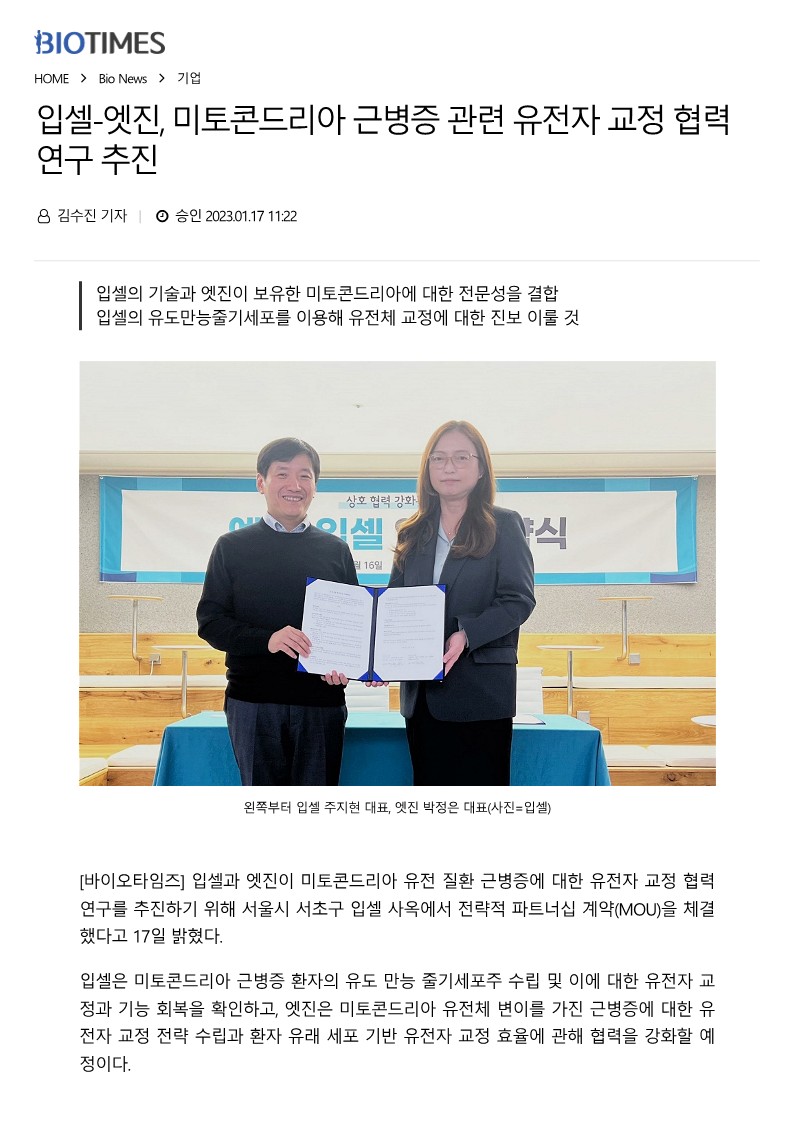News
News
-
 September 27, 2024유전자교정협의회 '최수진 의원 LMO법 개정안 환영...규제, 성장 막아선 안돼'
September 27, 2024유전자교정협의회 '최수진 의원 LMO법 개정안 환영...규제, 성장 막아선 안돼' -
 September 2, 2024미토이뮨 테라퓨틱스, 엣진과 희귀질환 치료제 개발 MOU체결
September 2, 2024미토이뮨 테라퓨틱스, 엣진과 희귀질환 치료제 개발 MOU체결 -
 September 2, 2024Engineering TALE-li
September 2, 2024Engineering TALE-linked deaminases to facilitate precision adenine ba se editing in mitochondrial DNA Cho et al. (2024). Engineering TALE-linked deaminases to facilitate precision base editing in mitochondrial DNA. Cell. 17, 95-109.DddA-derived cytosine base editors (DdCBEs) and transcription activator-like effector (TALE)-linked deaminases (TALEDs) catalyze targeted base editing of mitochondrial DNA (mtDNA) in eukaryotic cells, a method useful for modeling of mitochondrial genetic disorders and developing novel therapeutic modalities. Here, we report that A-to-G-editing TALEDs but not C-to-T-editing DdCBEs induce tens of thousands of transcriptome-wide off-target edits in human cells. To avoid these unwanted RNA edits, we engineered the substrate-binding site in TadA8e, the deoxy-adenine deaminase in TALEDs, and created TALED variants with fine-tuned deaminase activity. Our engineered TALED variants not only reduced RNA off-target edits by >99% but also minimized off-target mtDNA mutations and bystander edits at a target site. Unlike wildtype versions, our TALED variants were not cytotoxic and did not cause developmental arrest of mouse embryos. As a result, we obtained mice with pathogenic mtDNA mutations, associated with Leigh syndrome, which showed reduced heart rates.
-
 September 2, 2024아바타 테라퓨틱스, 엣진과 '미토콘드리아 AAV' 치료제 개발 MOU
September 2, 2024아바타 테라퓨틱스, 엣진과 '미토콘드리아 AAV' 치료제 개발 MOU -
 September 2, 2024ba
September 2, 2024base editing of organellar DNA with programmable deaminases Kim JS and Chen J (2024). Base editing of organellar DNA with programmable deaminases. Nat Review Mol Cell Biol. 25, 34-45.Mitochondria and chloroplasts are organelles that include their own genomes, which encode key genes for ATP production and carbon dioxide fixation, respectively. Mutations in mitochondrial DNA can cause diverse genetic disorders and are also linked to ageing and age-related diseases, including cancer. Targeted editing of organellar DNA should be useful for studying organellar genes and developing novel therapeutics, but it has been hindered by lack of efficient tools in living cells. Recently, CRISPR-free, protein-only base editors, such as double-stranded DNA deaminase toxin A-derived cytosine base editors (DdCBEs) and adenine base editors (ABEs), have been developed, which enable targeted organellar DNA editing in human cell lines, animals and plants. In this Review, we present programmable deaminases developed for base editing of organellar DNA in vitro and discuss mitochondrial DNA editing in animals, and plastid genome (plastome) editing in plants. We also discuss precision and efficiency limitations of these tools and propose improvements for therapeutic, agricultural and environmental applications.
-
 September 2, 2024입셀-엣진, 미토콘드리아 근병증 관련 유전자 교정 협력 연구 추진
September 2, 2024입셀-엣진, 미토콘드리아 근병증 관련 유전자 교정 협력 연구 추진


